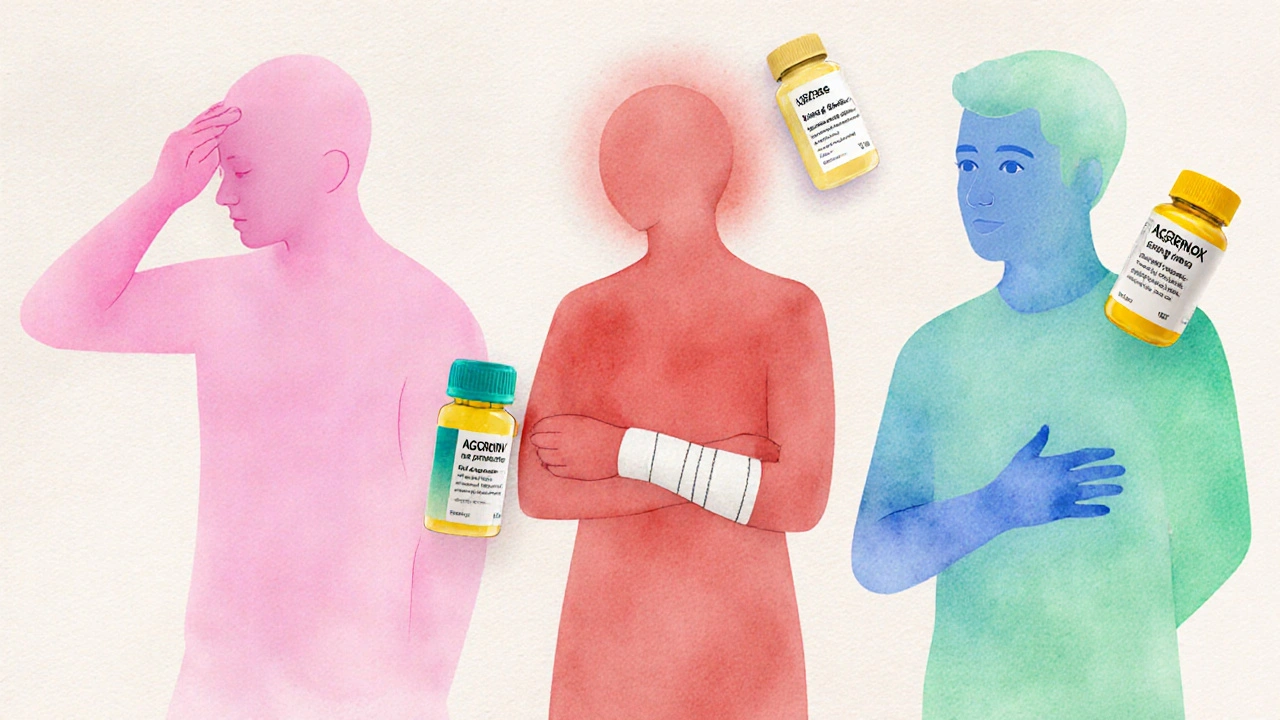Aggrenox vs. Alternatives: Stroke Prevention Comparison Tool
Recommendation
Select a medication and situation to get personalized recommendations based on clinical evidence and patient factors.
When a doctor prescribes a pill to stop another stroke, the choice isn’t always obvious. Aggrenox is a combination of dipyridamole and low‑dose aspirin, marketed for secondary stroke prevention. But dozens of other antiplatelet or anticoagulant options exist, each with its own pros and cons. This guide breaks down what Aggrenox actually does, how it stacks up against the most common alternatives, and which factors should drive your decision.
What is Aggrenox and How Does It Work?
Aggrenox is a fixed‑dose tablet that pairs 25mg dipyridamole with 75mg aspirin. Dipyridamole inhibits platelet aggregation by increasing cyclicAMP and blocking adenosine reuptake, while aspirin irreversibly acetylates cyclooxygenase‑1, reducing thromboxane‑A2 production. The duo targets two pathways, aiming for a stronger block against clot formation than aspirin alone.
Key attributes:
- Indication: secondary prevention after non‑cardioembolic ischemic stroke or transient ischemic attack (TIA).
- Typical regimen: one tablet twice daily with food to lessen headache.
- Common side effects: headache (up to 30% of users), gastrointestinal upset, and rare bleeding events.
- Contraindications: active peptic ulcer, severe liver disease, known hypersensitivity to either component.
- Cost in Canada (2025): approximately CAD45 for a 30‑day supply; many provincial plans cover a portion.
Major Alternatives on the Market
Below are the five most frequently considered alternatives for patients who can’t tolerate Aggrenox or whose clinicians prefer a different strategy.
- Aspirin monotherapy - low‑dose (81‑100mg) daily.
- Clopidogrel - a P2Y12 receptor antagonist taken once daily.
- Aspirin+Clopidogrel - dual antiplatelet therapy (DAPT) for a limited period post‑stroke.
- Ticagrelor - reversible P2Y12 inhibitor, often used in acute coronary settings but studied in stroke.
- Warfarin - oral vitaminK antagonist, reserved for cardioembolic sources (e.g., atrial fibrillation) but sometimes considered when antiplatelet therapy fails.
Side‑Effect Profiles at a Glance
| Medication | Headache | Bleeding risk | Gastro‑intestinal upset | Other notable effects |
|---|---|---|---|---|
| Aggrenox | 30% | Moderate (similar to low‑dose aspirin) | 15% | Dizziness, rare eosinophilia |
| Aspirin | 5% | Low‑moderate | 20% | Ulcer risk increases with chronic use |
| Clopidogrel | 2% | Low‑moderate | 10% | Possible rare rash, thienopyridine hypersensitivity |
| Aspirin+Clopidogrel | 8% | Higher (combined effect) | 25% | Increased ulcer risk, recommended only short‑term (≤90days) |
| Ticagrelor | 7% | Moderate‑high | 12% | Dyspnea (up to 15%); shortness of breath may limit use |
| Warfarin | 1% | High (INR‑dependent) | 5% | Dietary vitaminK restrictions, frequent INR monitoring |

Effectiveness in Preventing Recurrent Stroke
Large randomized trials provide the hard numbers:
- Aggrenox (ESPS‑2, 2001) reduced the combined risk of stroke, MI, or vascular death by 20% compared with aspirin alone.
- Aspirin monotherapy shows a modest 10‑15% relative risk reduction versus placebo in secondary prevention (meta‑analysis, 2019).
- Clopidogrel alone (CAPRIE, 1996) delivered a 8% reduction versus aspirin, better in patients with peripheral arterial disease.
- Aspirin+Clopidogrel (CHANCE, 2013; POINT, 2017) gave a 30‑35% short‑term drop in stroke recurrence, but the benefit faded after 90days, and bleeding rose sharply.
- Ticagrelor (SOCRATES, 2016) did not reach statistical superiority over aspirin for stroke recurrence, though it trended lower in high‑risk subgroups.
- Warfarin beats antiplatelet agents only when the stroke source is cardioembolic (e.g., atrial fibrillation), otherwise bleeding outweighs benefit.
Bottom line: for non‑cardioembolic ischemic strokes, Aggrenox remains one of the most evidence‑backed options, especially when a patient can tolerate dipyridamole’s headaches.
Choosing the Right Therapy: Decision Factors
- Stroke etiology - If the original clot came from atrial fibrillation, anticoagulation (warfarin or DOACs) is preferred. For large‑artery atherosclerosis or lacunar strokes, antiplatelet combos shine.
- Bleeding risk - Evaluate age, prior gastrointestinal bleed, and concurrent anticoagulants. Aggrenox’s bleeding risk mirrors low‑dose aspirin, making it safer than DAPT or ticagrelor for high‑bleed patients.
- Headache tolerance - Dipyridamole‑induced headache can be a deal‑breaker. If a patient reports frequent severe headaches, switching to clopidogrel or aspirin monotherapy may improve adherence.
- Drug interactions - Dipyridamole interacts with certain antihypertensives (e.g., beta‑blockers) and increases plasma levels of theophylline. Clopidogrel’s efficacy can be blunted by CYP2C19 loss‑of‑function alleles.
- Cost and access - Generic dipyridamole‑aspirin combos are cheaper than brand‑name ticagrelor. Provincial formularies often list Aggrenox as a preferred option for secondary stroke prevention.
- Patient preference - Twice‑daily dosing vs once‑daily regimens influences adherence. Some patients favor a single tablet (Aggrenox) over two separate pills (aspirin + dipyridamole).
Practical Switching Guide
If you’re moving from one regimen to another, follow these steps to keep protection high and side effects low.
- Consult your prescriber - Never stop a medication abruptly.
- Overlap period - When shifting to clopidogrel, maintain aspirin for 5‑7days to cover the gap in platelet inhibition.
- Monitor for headaches - If starting Aggrenox, advise taking the dose with meals and using acetaminophen for breakthrough headache.
- Laboratory checks - Warfarin requires INR checks 2‑3times weekly initially; other agents need routine CBC to spot occult bleeding.
- Re‑evaluate at 3 months - Assess adherence, side‑effects, and any new vascular events to decide if the current regimen still fits.
Bottom Line: When Aggrenox Is the Best Bet
Aggrenox shines in patients who:
- Had a non‑cardioembolic ischemic stroke or TIA.
- Can tolerate dipyridamole’s headache or have a mild one that responds to simple analgesics.
- Need a stronger antiplatelet effect than aspirin alone but want to avoid the higher bleeding risk of DAPT.
- Prefer a twice‑daily single tablet over taking two separate pills.
If any of those conditions don’t apply-especially if the patient has a high bleeding risk, severe headache intolerance, or a known CYP2C19 poor metabolizer status-consider clopidogrel or aspirin monotherapy as simpler, safer alternatives.

Frequently Asked Questions
Can I take Aggrenox if I’m already on a blood thinner?
No. Combining Aggrenox with oral anticoagulants (warfarin, DOACs) dramatically raises bleeding risk. Your doctor will choose either an antiplatelet regimen or an anticoagulant based on the stroke’s cause.
Why does dipyridamole cause headaches?
Dipyridamole dilates cerebral blood vessels, which can increase intracranial pressure and trigger headache. Taking the tablet with food and staying hydrated often helps, and over‑the‑counter acetaminophen can relieve the pain.
Is Aggrenox covered by provincial drug plans?
Most British Columbia PharmaCare formularies list Aggrenox as a preferred option for secondary stroke prevention, so a large portion of the cost is reimbursed for eligible patients. Check your specific provincial plan for exact coverage details.
How long should I stay on Aggrenox after my stroke?
Guidelines recommend indefinite therapy as long as the underlying risk factors (e.g., hypertension, atherosclerosis) remain. Periodic review every 6‑12months is advisable to assess tolerance and efficacy.
Should I switch to clopidogrel if I keep getting headaches?
Yes, many clinicians move patients who cannot tolerate dipyridamole to clopidogrel 75mg daily. It provides comparable stroke‑prevention benefit without the vasodilatory headache, though you should test for CYP2C19 variants if you have a history of poor response.


16 Comments
When I wander through the corridors of medical decisions, I can’t help but feel the drama of choosing between a pill that promises to stitch a broken brain and the countless alternatives that whisper their own promises. Aggrenox, with its double‑acting dance of dipyridamole and aspirin, seems like a poetic duet, yet the headache it summons can feel like a tragic chorus. The very act of swallowing a tablet that may cause a storm in your skull makes me wonder whether we are taming a beast or merely feeding it. In the grand theater of secondary stroke prevention, the stakes are as high as any Shakespearean climax. The side‑effect profile is a mosaic of pain, bleeding, and gastrointestinal discomfort, each piece demanding its own spotlight. Some patients find the 30% headache rate unbearable, while others tolerate it as a minor inconvenience for the sake of reduced stroke risk. The cost, hovering around CAD 45, sits uncomfortably between cheap aspirin and pricier brand‑only agents, making it a middle‑ground contender. The regimen’s twice‑daily schedule can be a chore, yet for some the convenience of a single combined pill outweighs the burden. Ultimately, the decision feels less like a calculation and more like a personal saga, where each individual must weigh the drama of potential benefits against the tragedy of side effects.
It’s comforting to see a clear breakdown of when headaches become the deal‑breaker.
From a clinical standpoint, the evidence supporting Aggrenox in non‑cardioembolic stroke prevention is robust and stems from large randomized trials such as ESPS‑2, which demonstrated a 20% relative risk reduction when compared with aspirin alone. This reduction is clinically meaningful, especially when considering the absolute risk of recurrent stroke in this population. The dual mechanism-dipyridamole’s phosphodiesterase inhibition combined with aspirin’s irreversible COX‑1 suppression-creates a synergistic antiplatelet effect that exceeds what either agent can achieve on its own. However, the adverse event profile cannot be ignored; the 30% incidence of headache associated with dipyridamole can lead to poor adherence, particularly in patients with a low tolerance for vasodilatory symptoms. Gastro‑intestinal upset, reported in roughly 15% of users, adds another layer of complexity, especially for individuals with a history of peptic ulcer disease. Bleeding risk with Aggrenox remains moderate, comparable to low‑dose aspirin, and is generally lower than that observed with dual antiplatelet therapy (DAPT) or ticagrelor. Cost considerations are also pertinent; while the $45 CAD price point is higher than generic aspirin, it is often covered partially by provincial drug plans, making it accessible for many patients. In terms of dosing convenience, the twice‑daily regimen may affect adherence for some, yet it offers the advantage of a single combined tablet versus taking multiple agents separately. For patients with a documented intolerance to dipyridamole‑induced headaches, switching to clopidogrel or aspirin monotherapy is a reasonable alternative, providing comparable efficacy with a more favorable side‑effect profile. Ultimately, the choice of antiplatelet therapy should be individualized, taking into account stroke etiology, bleeding risk, headache tolerance, drug interactions, and socioeconomic factors to optimize both efficacy and patient adherence.
Great rundown! I especially appreciate the clear table that lets you compare side‑effects at a glance.
Look, if we’re going to talk about “best bet” for stroke prevention, we need to remember that the United States has its own standards, and any drug that isn’t "Made in America" gets a free pass in the American patriotic imagination. Aggrenox might be a solid option elsewhere, but let’s not kid ourselves – the real battle is over who can push their pharmaceutical agenda without a war of words. The so‑called “moderate bleeding risk” is just a talking point to distract from the fact that most patients can’t even afford the monthly price tag without insurance – and insurance in the US is a whole different beast. So while the post praises Aggrenox for its double mechanism, the truth is the US market will always favor the cheaper, home‑grown alternatives, regardless of efficacy, because that’s how the system works.
Honestly, the jargon‑heavy breakdown feels more like a marketing flyer than a nuanced clinical discussion. The post glosses over the fact that dipyridamole’s vasodilatory action can be a nightmare for migraine‑prone patients, and it barely scratches the surface of drug‑drug interaction concerns, especially with antihypertensives. If you’re looking for a deep dive, you’ll need to couple this with the primary literature.
Oh wow, another “miracle combo” that will magically prevent strokes while you sip your coffee. Sure, Aggrenox sounds fancy, but the headache rate is basically a free coupon for an extra pharmacy visit. And let’s not forget the bleeding risk – “moderate” is just code for “might make you bleed like a leaky faucet.” In the grand scheme, you’re swapping one set of side‑effects for another. Thanks for the marketing copy, I guess.
Wow!!! This comparison tool is sooo helpful!!! I love how you can just pick a med and instantly see the pros and cons!!! The only thing I’d add is a reminder to take the pill with food to avoid those nasty stomach issues!!! Keep up the great work!!!
While the presented data are largely accurate, it is essential to approach the conclusions with a discerning eye. The superiority of Aggrenox in non‑cardioembolic strokes is supported by robust RCTs; however, the relative risk reduction must be contextualized against absolute event rates. Moreover, the discussion would benefit from a nuanced exploration of pharmacogenomics, particularly CYP2C19 polymorphisms influencing clopidogrel efficacy. 😊
When I reflect on the labyrinth of antiplatelet therapy, the ethical dimension becomes as crucial as the pharmacologic one. The decision to impose a medication that may cause frequent headaches is not merely a clinical judgment but an existential negotiation with the patient’s quality of life. One must weigh the intangible costs of discomfort against the tangible benefit of reduced stroke recurrence. In every prescription, there lies a silent dialogue between physician authority and patient autonomy, a dance of power that shapes health trajectories. Embracing this perspective encourages us to personalize therapy, not merely to follow protocols. If the patient cannot bear the vasodilatory aftermath of dipyridamole, seeking alternatives like clopidogrel respects their lived experience. Likewise, acknowledging socio‑economic constraints, such as drug coverage, honors the broader context in which health decisions unfold. Ultimately, the philosopher in me urges a balance between evidence and empathy, ensuring that the chosen regimen aligns with both scientific rigor and human dignity.
The table is clear, but remember to double‑check dosing guidelines for each medication.
Interesting take on the cost factor, I think it’s often overlooked.
Thanks for the breakdown 🙌 I’m leaning towards clopidogrel now because the headache thing sounds rough.
From a cultural perspective, many patients in South‑Asia rely heavily on aspirin due to its availability and cost, so recommendations must consider regional drug access.
Everything they say about "evidence" is just a smokescreen. Big Pharma pushes Aggrenox to keep us dependent, while hiding the real dangers. The bleeding risk is higher than they admit, and the headaches are just a way to get you to keep taking more meds. Wake up, folks!
Another shallow overview that fails to address the deeper issue of patient autonomy. The true problem isn’t the drug itself but the one‑size‑fits‑all approach the healthcare system forces upon us.
Write a comment